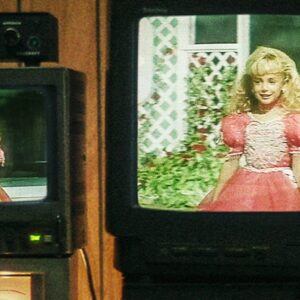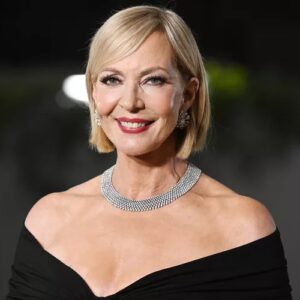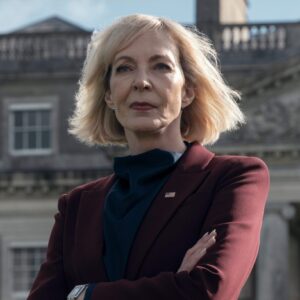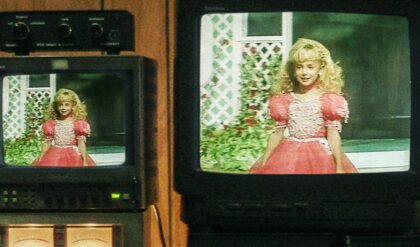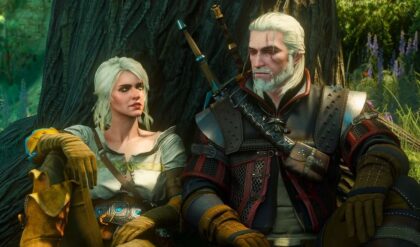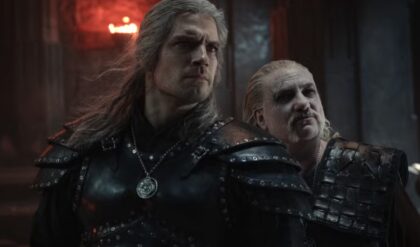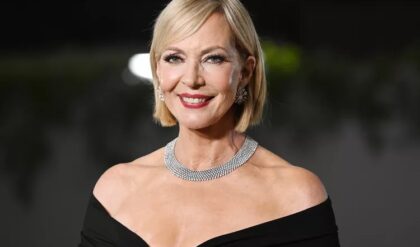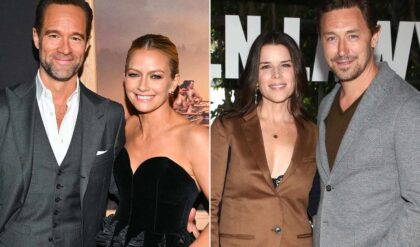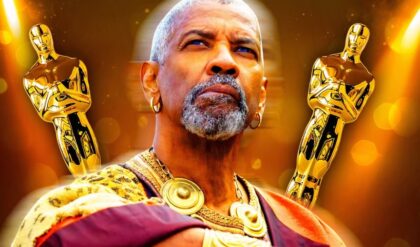
Hulu
There aren’t enough Native women on TV. But when they do get hired, they’re often playing cops.
“Not to take away from the performances of all these actresses, who I admire so much and are doing a beautiful job,” says Lily Gladstone, “but it’s almost the only role that we get to see.”
So it’s understandable that Gladstone had something of a checklist in hand when she first met with the producers of “Under the Bridge.” They were offering her the role of Cam Bentland, a police officer investigating the 1997 murder of Reena Virk (played by Vritika Gupta), a 14-year-old child of Indian immigrants in Saanich Core, British Columbia.
Cam, a Native woman adopted by a family of white cops, was the invention of series creator Quinn Shephard. Though realistic, the character is fictional; but the homicide at the center of the project is not. Often in the true crime genre, “it’s the victims who become the most marginalized in their story all over again,” says Gladstone. She needed to know that wasn’t going to happen before she could get involved in the project.
Shephard had written Cam with Gladstone in mind after seeing her in Kelly Reichardt’s 2016 film “Certain Women” — the same role that inspired Martin Scorsese to cast her in “Killers of the Flower Moon.” And there’s another crucial commonality the Scorsese film has with “Under the Bridge.”
“Killers” was based on a book by journalist David Grann about the Reign of Terror in 1920s Osage County, Okla., but “I had seen the success of also optioning a book that underwrote the whole story,” Gladstone says. She’s referring to “A Pipe for February,” the 2002 novel by Osage author Charles H. Red Corn that helped Scorsese better understand his characters. Similarly, “Under the Bridge” is an adaptation of the book of the same name by Rebecca Godfrey and follows the author (Riley Keough) as she observes the teenagers involved in Reena’s murder. However, it was the memoir of Reena’s father, Manjit Virk (played by Ezra Faroque Khan), that helped Shephard and fellow showrunner Samir Mehta honor who Reena was in life.
“By nature of the book that Rebecca wrote, it would have been a falsehood for her to create Reena as a character — she never got to meet her. But having Manjit’s book broaden that conversation, you have the victim in every episode,” Gladstone says. “You get a chance to love her. She’s not just a young brown woman’s body experiencing violence. This is a human being attached to a generations-long legacy in history. You feel the immensity of the loss when you see who she is in the landscape of her whole family and get to know her as a girl you could be friends with.”
There’s a “loaded conversation” that comes with depicting a Native adoptee in Canada, Gladstone says, especially one in a family of cops. So, after feeling confident that “Under the Bridge” would treat Reena with care, she had questions to ask about Cam’s family history. Shephard and Mehta had answers.
One of the darkest blotches in Canadian history is the Sixties Scoop, which Gladstone describes as an “insidious government initiative that literally plucked Indigenous kids out of their families and advertised them in the paper like puppies.” Through a group of laws and protocols now widely acknowledged to have created a mass abduction program, it’s estimated that some 20,000 Native children were wrongly removed from their families, placed into foster care and adopted out to white people during the Scoop. As “Under the Bridge” concludes, Cam finds out she’s one of them.
Cam had always been told that she was covered in bruises when she was found but realizes when she gets ahold of her adoption file that those signs of “abuse” were really just birthmarks. “That was the justifying reason for a lot of those social workers,” Gladstone explains. “The banality of that — how viscerally disgusting. They’re precious. It’s something you’re proud of, that your kids have little markings that show that they’re yours, and that becomes the thing that takes them away.”
Gladstone adds, “The cop persona is an imposed one,” and Cam begins subconsciously shedding that imposition even before she learns the truth. “Toward the last episodes, Cam’s wearing less and less of her uniform. Her body language is changing toward the other officers through all of it, culminating in what you see in the final episode.”
Cam reveals to Rebecca in those last minutes of “Under the Bridge” that she’s resigning from the force. “That’s kind of the exclusive way that I was going to play a cop: a cop who eventually ditches the badge,” Gladstone says. “Maybe the Indigenous woman cop is a compelling character because it’s a contradiction. It’s having this desire to protect your community, but then seeing that you’re being mobilized against your own people.”
Given confidence in the show’s vision by that ending, she signed on and continued to deepen the character with additions of her own. Namely, she decided that Cam was of the Tsleil-Waututh Nation, originating from the Burrard Inlet in what is now Vancouver. At the beginning of “Under the Bridge,” Cam has plans to advance her career by moving to Vancouver, a desire Gladstone “wanted to make bigger than Cam even realized. I wanted her internal compass to be pointing to Vancouver for a different reason.”
She also wanted to give “a little nod” to Chief Dan George, the Tsleil-Waututh star of “Little Big Man,” who, in 1971, became the first North American Indigenous actor nominated for an Academy Award. The most recent Indigenous actor nominated for an Academy Award, of course, was Gladstone.
There’s a consensus among pundits that Gladstone would have won an Oscar for “Killers of the Flower Moon” had she’d campaigned as a supporting actress instead of in the lead category, where she lost to Emma Stone. Gladstone doesn’t care.
“I never decided I needed to improve my odds or boost my career. That was my last thought,” she says frankly. “Campaigning Molly as a lead wasn’t about me. If I was ultra-consumed with that, maybe it would have shaken out differently. But it doesn’t make sense to me. The heart of the whole story, the access point for the humanity, is Osage. I never saw Molly as a supporting role. Your heart is not a supporting
organ. Your soul and your conscience are not supporting voices. It’s the compass of everything.”
She continues: “People will make what they want, but I’m glad that what other women of color have taken away from it is that we don’t always need to accept supporting positions. We’re very strong when we are supporting, but it’s also really powerful to just accept that we lead. Because that’s what we do.”
The opposite scenario is true for “Under the Bridge,” for which Gladstone and Keough are both campaigning in the supporting category. “Riley and I, we’re the ones on the poster. We’re the ones you would say are billed as the leading actresses,” Gladstone says, “but our characters are there to support the story of Reena Virk.”
News
Who Killed JonBenét Ramsey? Reexamines One of the Biggest Cold Cases in History
On Dec. 26, 1996, John and Patsy Ramsey awoke to a nightmare. Their youngest child, 6-year-old JonBenét Ramsey, was missing, with a chilling ransom note left behind. The day took a devastating turn when John Ramsey discovered JonBenét’s lifeless body…
Allison Janney Says She ‘Threw the Script Across the Room’ for The Diplomat Season 2 Finale
Allison Janney. Photo: Gilbert Flores/Variety via Getty Allison Janney is revealing how she reacted to seeing one specific script for The Diplomat. During an appearance on Jimmy Kimmel Live! on Nov. 4, Janney, 64, explained that when she first read the script for the political thriller’s season…
Inside The Lincoln Lawyer cast’s real-life romances: Manuel Garcia-Rulfo, Neve Campbell, Becki Newton and more
The Lincoln Lawyer promises plenty of drama both in the courtroom and out but offscreen the stars of the show live regular lives with their loved ones. The romantic complexities on the legal Netflix series aren’t reflected in their real-life…
The Ending of ‘The Diplomat’ Season 2, Explained: Breaking Down Who Planned the Attack and the Shocking Death
(Image credit: Courtesy of Netflix) Season 2 of Netflix’s political thriller The Diplomat begins with a bang—literally. Created by The West Wing alum Debora Cahn and starring Keri Russell, the series follows the titular diplomat Kate Wyler (Russell) as she’s appointed ambassador to the United…
Murder Mindfully: Streaming details, plot, cast and more about the British anthology series
f you’ve been busy celebrating the spookiest time of the year and missed out on watching Tom Schilling’s latest crime-comedy drama Murder Mindfully, this is the perfect time to catch up with the thrills. The dark comedy follows the narrative by…
What Caitlyn Jenner’s kids called her after her transition has fans turning heads
Bruce Jenner, the Olympic gold medal-winning decathlete, transitioned into a woman and that decision caused quite a stir back in the day. Jenner, a father of five, including two of the sisters of the Kardashian clan, Kylie and Kendall, was…
End of content
No more pages to load

